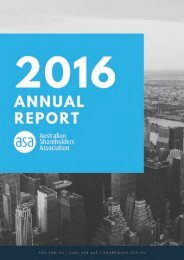eq-2014-12
eq-2014-12
eq-2014-12
You also want an ePaper? Increase the reach of your titles
YUMPU automatically turns print PDFs into web optimized ePapers that Google loves.
From ASIC,<br />
the financial<br />
regulator<br />
Get to know your super<br />
By Miles Larbey, Senior Executive Leader, ASIC’s MoneySmart team<br />
Getting to know their super is something many Australians<br />
put off because they may have more pressing financial issues.<br />
But taking a few small steps now can make a real difference.<br />
You’ll be able to watch your super savings grow and improve<br />
your financial future.<br />
LOG IN TO YOUR SUPER ACCOUNT<br />
In a recent poll on ASIC’s MoneySmart website, around 6 in 10<br />
people said they know how much they have in super. Around<br />
4 in 10 said they either didn’t know, or only ‘sort of’ know how<br />
much super they have. This suggests many Australians could<br />
benefit from finding out more about their super.<br />
Most super funds have a lot of information online. If you’ve<br />
never checked out your fund’s website then this is the first<br />
thing you should do.<br />
You may need to create a username and password. Once<br />
you’ve done this, log in and find out about:<br />
• What investment options you can choose<br />
• What fees you’ll pay<br />
• Death and disability benefits and insurance premiums<br />
• Other fund features and services.<br />
You may also be able to download statements about your<br />
account and see your balance.<br />
CONSIDER YOUR INVESTMENT OPTIONS<br />
If you’ve never made an active choice about how your money<br />
is invested, your money will be put into a fund that offers a<br />
MySuper investment option. This is a simple default option.<br />
However, most funds offer a range of investment choices.<br />
When deciding between investment options, consider:<br />
• Your age<br />
• How comfortable you are with investment risk<br />
• How long before you are able to access your funds<br />
For example, if you’re unlikely to be accessing your super<br />
for at least five years, focus on growing your total benefit.<br />
Alternatively, if you’re retiring and intend to withdraw all your<br />
super in less than five years, you may want to know exactly<br />
how much you’ll have – and not risk losing any of it in the<br />
meantime. A lower risk, lower return strategy will help preserve<br />
the value of your savings.<br />
The fund’s product disclosure statement (PDS) will give you<br />
more information about your investment options.<br />
‘LIFE CYCLE’ INVESTMENT OPTION<br />
Some funds offer a ready-made investment strategy, usually<br />
based on age. If you choose this strategy, your fund will select<br />
an appropriate investment mix based on your age at the time.<br />
Then, at pre-determined intervals the fund will automatically<br />
switch your savings into a more defensive mix.<br />
Typically, over the course of your working life, your investment<br />
strategy progressively changes from growing to preserving<br />
your balance.<br />
FIND OUT WHAT FEES YOU’RE PAYING<br />
Super funds charge different fees for managing your account,<br />
contributions, insurance and more. As a general rule, the less<br />
you pay in fees the more your super will grow.<br />
You can find out what fees you’re being charged in your annual<br />
statement, on the fund’s website or in the PDS. Fees can be<br />
either a dollar amount or a percentage.<br />
MySuper accounts generally have lower fees and can only<br />
charge certain types of fees. If you’re looking for a low fee<br />
option, talk to your super fund about whether a MySuper<br />
account is right for you.<br />
To find out if your super fund is charging you high or low<br />
fees, compare it to other similar funds. MoneySmart has a<br />
superannuation calculator to help you do this.<br />
DO YOU NEED INSURANCE<br />
Super funds typically offer death cover (also known as life<br />
insurance or term life cover), total and permanent disability<br />
cover and income protection cover.<br />
Being insured through super is generally an easy option – and<br />
cost-effective because premiums are paid from your pre-tax<br />
income. Insurance premiums are usually deducted from your<br />
super account, which reduces your super, unless your employer<br />
pays for your cover.<br />
Think about whether to take up or keep the insurance<br />
protection your fund provides, or whether you want more<br />
cover. If your situation is complex, consider getting professional<br />
financial advice.<br />
SHOULD YOU CONSOLIDATE YOUR ACCOUNTS<br />
If you have money in more than one fund you may decide<br />
to consolidate it into a single fund. This will make it easier<br />
to manage your super and you will only pay one set of fees.<br />
Before you decide which fund to use, it’s a good idea to see<br />
what each fund offers.<br />
Consolidating accounts is a lot easier than it used to be<br />
with the free SuperSeeker tool available via the ATO’s online<br />
services at ato.gov.au. In the process, you may find you have<br />
some ‘lost super’.<br />
It can be hard to find the motivation to engage with your<br />
super because retirement may seem a long way away, but if<br />
you take a few small steps to understand your situation now,<br />
it can make a real difference in the long run.<br />
ASIC’s MoneySmart website at moneysmart.gov.au, has more information<br />
and calculators to help you make the most of your super.<br />
EQUITY December <strong>2014</strong> Page 18




